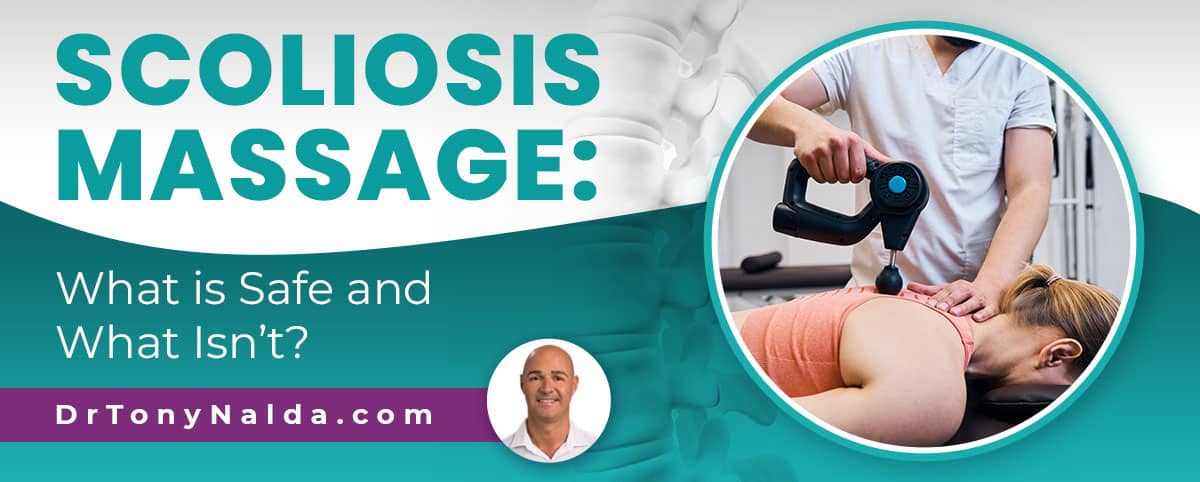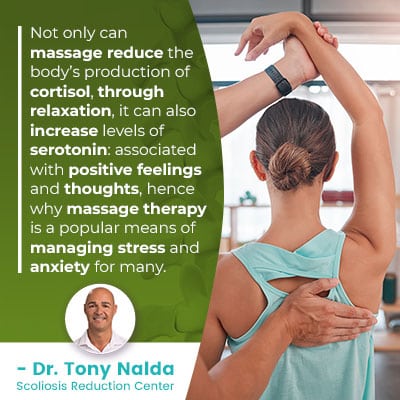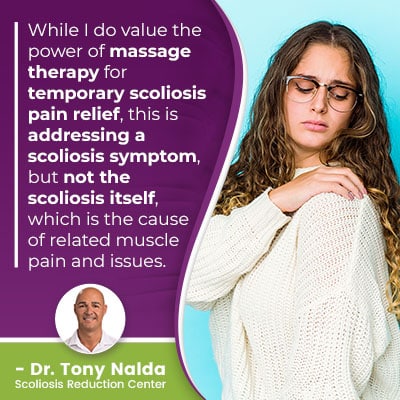Scoliosis Massage: What is Safe and What Isn't?

Muscle pain and imbalance is a symptom of scoliosis, and this is due to the uneven forces the condition introduces to the body. Scoliosis massage can help loosen tight and sore muscles for pain relief, but doesn’t actually strengthen them or address muscle imbalance, so is not considered a form of scoliosis treatment.
It’s easy to blur the lines between treating a condition, or the condition’s symptoms. As a structural condition, treatment has to impact scoliosis on a structural level. Massage can help with pain management, but results are short term, and no form of scoliosis massage can correct a scoliosis.
Before getting to the specifics of scoliosis massage, let’s first talk about massage, and its general effects on the body.
Table of Contents
The Power of Massage Therapy
When it comes to the power of massage therapy, I’m a supporter of its uses for addressing muscular issues, but not structural ones.
Massage, when performed correctly, can actually cause physiological changes in the body, known as the relaxation response, which is related to mechanical responses.
Muscular Relaxation Response
Most often, regular massage therapy has two main purposes: pain relief and relaxation. The muscular relaxation response is how the nervous system responds to touch during a massage.
If a person getting a massage is experiencing relief from pain and discomfort, relaxation is the result, and this impacts the heart rate, breathing patterns, and blood pressure.
Production of the stress hormone, cortisol, is also reduced, which further encourages the muscles to relax.
The relaxation response is a remedy for muscle stiffness and tightness, not to mention the benefits that pain relief can bring to patients' mental wellbeing.
 Not only can massage reduce the body’s production of cortisol, through relaxation, it can also increase levels of serotonin: associated with positive feelings and thoughts, hence why massage therapy is a popular means of managing stress and anxiety for many.
Not only can massage reduce the body’s production of cortisol, through relaxation, it can also increase levels of serotonin: associated with positive feelings and thoughts, hence why massage therapy is a popular means of managing stress and anxiety for many.
Massage therapy is also associated with certain mechanical responses.
Mechanical Responses
Deep-tissue massage therapy can help produce mechanical responses within the body by stimulating the soft tissues through pressure applied during massage.
The physical manipulation of muscles that occurs during massage therapy can lead to physical changes inside the body such as increased circulation, and the normalization and relaxation of muscle, tendons, connective tissue, and ligaments, and this has the potential to impact nerves and deeper connective tissue.
As soft tissue is manipulated and circulation is improved, the relaxation response also is associated with the release of chemicals and the delivery of oxygen and nutrients throughout the body's cells and muscle groups; cellular health is improved and can lead to muscle tissues experiencing functional improvement, meaning any soft-tissue swelling is likely to be reduced.
Relaxing Muscle Tissue
The majority of muscle pain is caused by contractions and spasms, and massage therapy can help relax muscle tissue, which reduces these types of negative muscle responses.
As a muscle contracts, it's compressing surrounding nerves, which causes related pain and discomfort; conversely, when a muscle relaxes, the nerves are relieved of compression.
If nerve compression is reduced, the ability of the nerves to send signals/messages back and forth to the brain is improved, facilitating the optimal functioning of muscles.
So these benefits make massage therapy a helpful resource for those suffering from stress, muscle cramps, spasms, and tightness because of its ability to help relax sore muscles and address muscular pain.
Now, general massage therapy can help with a number of the aforementioned issues, but scoliosis is a highly-complex condition so would benefit more from a specific scoliosis massage therapy, but even with that specialization, at best, the result is temporary relief.
Pain can be reduced during the massage, but those results aren't long term and are likely to be gone by the time the patient returns home; this is because scoliosis is structural, so massage isn't addressing the condition itself, but more so a symptoms of the condition: muscle pain and stiffness.
The pain relief provided by a massage will be temporary because those contracted and sore muscles will return as the muscle imbalance and asymmetry is caused by the structural nature of scoliosis, which massage can't impact.
Understanding the Structural Nature of Scoliosis
A diagnosis of scoliosis means there is an unnatural sideways spinal curve, with rotation, making it a 3-dimensional condition, involving a structural abnormality within the spine itself.
So while massage therapy can help manage scoliosis symptoms such as muscle pain, contractions, and spasms, it's ineffective as a form of scoliosis treatment because scoliosis is a structural condition, not a muscular condition.
Scoliosis massage can address related pain and discomfort, but this is addressing scoliosis symptoms, not the underlying structural nature of the condition itself.
A feature of scoliosis is that it's progressive, meaning it has it in its nature to worsen over time, and as scoliosis progresses, the spine becomes more rigid, and less responsive to treatment options.
A spine that's loose and flexible is going to respond more readily to manual adjustments and a variety of chiropractic techniques.
It's the related spinal rigidity that contributes to the tight muscles that surround the spine, so while scoliosis massage therapy can help with temporary relaxation and loosening tight muscles, when the massage is over, so too is the relaxation response, but the spine's rigidity that caused the muscle tightness remains.
The rigidity of a scoliotic spine is also what contributes to the tightening of the spine's surrounding muscles.
While massage techniques for scoliosis might allow for some temporary relaxation and loosening of those muscles, when the massage is over, the relaxation effect is over as well, while the spine’s rigidity that’s causing the muscle tightness remains.
Scoliosis being a structural condition means that no change in position can reduce the unnatural spinal curve, so if a patient's movement and effort to straighten out their spine is ineffective, rubbing their paraspinal muscles won't reduce the curve either.
Muscle Imbalance and Scoliosis
The development of scoliosis means one or more of the spine's healthy curves have been lost and replaced by unhealthy curves that cause postural changes: rib deformity, uneven shoulders, uneven hips, arms and legs that appear to hang at different lengths, etc.
The disruption to the body's overall symmetry also affects muscle tone as it's not just the spine that's in charge of maintaining its natural curves and alignment, but also its surrounding muscles; if the asymmetry of the spine didn't affect muscle tone, people with scoliosis wouldn't be able to remain upright.
Tight muscles aren't causing scoliosis; scoliosis is causing muscle imbalance (asymmetrical muscles).
In conditions caused by muscle asymmetry, such as injured or strained muscles, a massage therapist can help produce a lasting response because the underlying issue is muscular; in scoliosis, the muscles are reacting to the unnatural spinal curve, and nothing else.
 While I do value the power of massage therapy for temporary scoliosis pain relief, this is addressing a scoliosis symptom, but not the scoliosis itself, which is the cause of related pain and muscle issues.
While I do value the power of massage therapy for temporary scoliosis pain relief, this is addressing a scoliosis symptom, but not the scoliosis itself, which is the cause of related pain and muscle issues.
It's important for patients to understand the difference between treating scoliosis symptoms, or the condition itself; no amount of massage therapy has corrective potential in the short or long term.
Remember, scoliosis-related muscle issues are caused by muscle imbalance/strain caused by the asymmetrical spine and its effects on the rest of the body.
When is Massage Not Safe for Scoliosis?
There was once a time when scoliosis was thought to be caused by muscle tightness: the thought being that the muscles and muscle tone inside was excessively tight, causing muscle imbalance that led to the development of an unnatural spinal curve.
Medical research has tested the validity of this theory; a group of scoliosis patients were exposed to muscle stimulation on the curve's outer edge in an attempt to tighten weak muscles, increase muscle strength, and straighten the asymmetry.
Transcutaneous electrical stimulation (TENS) was used to make these muscles more flacid to allow for more movement of the spine; that's what they anticipated, but the result was that every single scoliotic curve progressed.
The results showed that tight muscles are holding the spine, not causing the unnatural curve to develop/progress.
In theory, if massage therapy could work at the same level as muscle stimulation and TENS to actually alter affected nerves, it could be harmful, but in reality, that level of deep spinal musculature isn't accessible solely through massage.
If a massage therapist could reach the level of deep spinal musculature with the same intensity as TENS, it could be contraindicated because as the body tries to stabilize itself, massage could be disrupting that normal defensive response.
Ultimately, I don't think massage therapy is powerful enough to cause that kind of harm to scoliosis patients because affecting scoliosis structurally is beyond its scope.
Conclusion
Scoliosis massage is not an effective form of treatment, and this is because it can't impact the condition on a structural level.
What scoliosis massage can help with is managing related pain and muscle stiffness on a short-term basis.
When massage is bad for scoliosis is when people make the mistake of assuming that massage is a form of treatment, so don't seek out actual proactive treatment plans that impacts scoliosis on every level for true corrective results.
Here at the Scoliosis Reduction Center, while increasing core strength so the spine is optimally supported by its surrounding muscles is one facet of treatment, as we reduce the curve on a structural level via condition-specific chiropractic care, muscles also relax and repair on their own; this is because the underlying cause of related muscle issues, the scoliosis itself, is being proactive treated.
So scoliosis massage is safe in terms of its ability to reduce muscle strain and imbalance, and when it's not safe is when it's being used to replace actual treatment, which can amount to allowing a curve to progress unimpeded.
When it comes to scoliosis treatment options, there is no quick fix. Reducing a structural abnormality within the spine itself requires proactive treatment capable of impacting the condition structurally by reducing the curve, and this is the only way to achieve actual corrective results for relieving pain long term.
Dr. Tony Nalda
DOCTOR OF CHIROPRACTIC
After receiving an undergraduate degree in psychology and his Doctorate of Chiropractic from Life University, Dr. Nalda settled in Celebration, Florida and proceeded to build one of Central Florida’s most successful chiropractic clinics.
His experience with patients suffering from scoliosis, and the confusion and frustration they faced, led him to seek a specialty in scoliosis care. In 2006 he completed his Intensive Care Certification from CLEAR Institute, a leading scoliosis educational and certification center.
About Dr. Tony Nalda
 Ready to explore scoliosis treatment? Contact Us Now
Ready to explore scoliosis treatment? Contact Us Now





